Impacts of Ecological Engineering Interventions on Carbon Sequestration: Spatiotemporal Dynamics and Driving Mechanisms in Karst Rocky Desertification Control
Abstract
1. Introduction
2. Materials and Methods
2.1. Overview of Ecological Engineering
2.2. Study Area
2.3. Data Sources
2.4. Research Methodology
2.4.1. Forest Carbon Storage
2.4.2. Carbon Density Correction
2.4.3. InVEST Model
2.4.4. Hot Spot Analysis InVEST Model
2.4.5. Correlation Analysis
2.4.6. Moran Index
3. Results
3.1. Spatiotemporal Characteristics of Total Carbon Storage
3.2. Analysis of Carbon Storage Under Different Ecological Engineering
3.3. Analysis of Driving Factors
4. Discussion
4.1. Analysis of Carbon Storage in Different Regions
4.2. Impact of Different Measures on Ecological Projects
4.3. Limitations and Future Research Directions
5. Conclusions
- (1)
- Under the positive influence of ecological engineering, carbon storage increased at an annual growth rate of 0.46% from 2000 to 2015; land use changes led to a 3.31% decrease in carbon storage in 2020. In 2019 and 2020, the carbon storage of ecological engineering exceeded the predicted values, demonstrating a more positive effect.
- (2)
- Among ecological projects, GFGP (Grain-for-Green Program) has the largest area and highest carbon storage; carbon density across all projects has continued to grow, with WFMP (Welfare Forest Management Program) maintaining the highest carbon density due to strict management and protection measures that promote natural restoration.
- (3)
- Natural factors (such as elevation) primarily drive the concentration of carbon storage hotspots in southwestern valley regions (2020). The impact of rock desertification on carbon storage may vary across different regions.
Author Contributions
Funding
Data Availability Statement
Acknowledgments
Conflicts of Interest
References
- Zhang, Y.; Zhang, Z.; Zhang, M.; Yuan, Z. The global situation of karst desertification research based on forest ecology. Forests 2024, 15, 126. [Google Scholar] [CrossRef]
- Wen, D.; Huang, Y.; Huang, Y.; Ding, N.; Ni, K.; Wang, H.; Müller, C. Karst rocky desertification restoration increases soil inorganic N supply to reduce plant N limitation. Catena 2024, 241, 108012. [Google Scholar] [CrossRef]
- Jiang, Z.; Lian, Y.; Qin, X. Rocky desertification in Southwest China: Impacts, causes, and restoration. Earth-Sci. Rev. 2014, 132, 1–12. [Google Scholar] [CrossRef]
- Zhu, M.; Zhou, Z.; Wu, X.; Liu, R.; Zheng, J.; Wang, J.; Wan, J. Response of vegetation carbon sequestration potential to the effectiveness of vegetation restoration in karst ecologically fragile areas in Guizhou, southwest China. Ecol. Indic. 2024, 158, 111495. [Google Scholar] [CrossRef]
- Lu, Q.; Zhao, C.; Huang, H. Comparative study on the temporal and spatial evolution of the ecosystem service value of different karst landform types: A case study in Guizhou Province, China. Appl. Sci. 2022, 12, 12801. [Google Scholar] [CrossRef]
- Zhang, J.Y.; Dai, M.H.; Wang, L.C.; Zeng, C.F.; Su, W.C. The challenge and future of rocky desertification control in karst areas in southwest China. Solid Earth 2016, 7, 83–91. [Google Scholar] [CrossRef]
- Ding, Y.L.; Zhou, Y.C. Study on the coupling relationship between slope, soil thickness, and rock exposure rate in a karst small watershed. Soil Bull. 2019, 50, 1053–1061. (In Chinese) [Google Scholar]
- Bussotti, F.; Pollastrini, M. Opportunities and threats of Mediterranean evergreen sclerophyllous woody species subjected to extreme drought events. Appl. Sci. 2020, 10, 8458. [Google Scholar] [CrossRef]
- Yin, R.; Yin, G. China’s primary programs of terrestrial ecosystem restoration: Initiation, implementation, and challenges. Environ. Manag. 2010, 45, 429–441. [Google Scholar] [CrossRef]
- Zhi, L.; Yang, M.; Qing, X.Y.; Xu, H.L.; Liu, Y.; Zhao, Y.T. Evaluation of the sustainable development capacity of the western returning farmland to forest project: A case study of Heqing County, Yunnan Province, Zhijin County, Guizhou Province, and Chaotian District, Sichuan Province. Sci. Silvae Sin. 2010, 46, 161–168. (In Chinese) [Google Scholar]
- Zhang, L.G.; Zhi, L.; Wang, G.Y.; Li, Y. Factors influencing farmers’ satisfaction with the returning farmland to forest project and improvement paths: Based on survey data from Heqing County, Yunnan Province, and Zhijin County, Guizhou Province. Sci. Silvae Sin. 2019, 55, 123–132. (In Chinese) [Google Scholar]
- Xi, H.; Li, T. Unveiling the spatiotemporal dynamics and influencing factors of carbon stocks in the Yangtze River Basin over the past two decades. Sci. Total Environ. 2024, 954, 176261. [Google Scholar] [CrossRef] [PubMed]
- Zhou, J.; Zhao, Y.; Huang, P.; Zhao, X.; Feng, W.; Li, Q.; Xue, D.; Dou, J.; Shi, W.; Wei, W.; et al. Impacts of ecological restoration projects on the ecosystem carbon storage of inland river basin in arid area, China. Ecol. Indic. 2020, 118, 106803. [Google Scholar] [CrossRef]
- Bergen, S.D.; Bolton, S.M.; Fridley, J.L. Design principles for ecological engineering. Ecol. Eng. 2001, 18, 201–210. [Google Scholar] [CrossRef]
- Xu, X.; Jiao, F.; Lin, D.; Liu, J.; Zhang, K.; Yang, R.; Zou, C. Carbon sink trends in the karst regions of Southwest China: Impacts of ecological restoration and climate change. Land 2023, 12, 1906. [Google Scholar] [CrossRef]
- Xu, X.; Liu, J.; Jiao, F.; Zhang, K.; Ye, X.; Gong, H.; Zou, C. Ecological engineering induced carbon sinks shifting from decreasing to increasing during 1981–2019 in China. Sci. Total Environ. 2023, 864, 161037. [Google Scholar] [CrossRef]
- Luo, D.; Zhou, Z.; Zhang, L.; Chen, Q.; Huang, D.; Feng, Q.; Wu, T.; Wu, L. Evolution and driver analysis of forest carbon stocks in karst mountainous areas of southwest China in the context of rocky desertification management. Catena 2024, 246, 108335. [Google Scholar] [CrossRef]
- Lin, T.; Wu, D.; Yang, M.; Ma, P.; Liu, Y.; Liu, F.; Gan, Z. Evolution and simulation of terrestrial ecosystem carbon storage and sustainability assessment in Karst Areas: A case study of Guizhou Province. Int. J. Environ. Res. Public Health 2022, 19, 16219. [Google Scholar] [CrossRef]
- Pan, Y.D.; Birdsey, R.A.; Fang, J.Y.; Houghton, R.; Kauppi, P.E.; Kurz, W.A.; Phillips, O.L.; Shvidenko, A.; Lewis, S.L.; Canadell, J.G.; et al. A large and persistent carbon sink in the world’s forests. Science 2011, 333, 988–993. [Google Scholar] [CrossRef]
- Zhang, H.; Feng, Z.; Shen, C.; Li, Y.; Feng, Z.; Zeng, W.; Huang, G. Relationship between the geographical environment and the forest carbon sink capacity in China based on an individual-tree growth-rate model. Ecol. Indic. 2022, 138, 108814. [Google Scholar] [CrossRef]
- Egusa, T.; Nakahata, R.; Neumann, M.; Kumagai, T. Carbon stock projection for four major forest plantation species in Japan. Sci. Total Environ. 2024, 927, 172241. [Google Scholar] [CrossRef]
- Li, H.; Hiroshima, T.; Li, X.; Hayashi, M.; Kato, T. High-resolution mapping of forest structure and carbon stock using multi-source remote sensing data in Japan. Remote Sens. Environ. 2024, 312, 114322. [Google Scholar] [CrossRef]
- Paul, T.S.H.; Wakelin, S.J. New Zealand’s planted forests-carbon stocks and yield in fast growing exotic tree plantations of the Southern Hemisphere. Trees For. People 2024, 16, 100590. [Google Scholar] [CrossRef]
- Clifton, B.; Ghezzehei, T.; Viers, J.H. Carbon stock quantification in a floodplain restoration chronosequence along a Mediterranean-montane riparian corridor. Sci. Total. Environ. 2024, 946, 173829. [Google Scholar] [CrossRef]
- Fu, K.; Chen, L.; Yu, X.; Jia, G. How has carbon storage changed in the Yili-Tianshan region over the past three decades and into the future? What has driven it to change? Sci. Total Environ. 2024, 945, 174005. [Google Scholar] [CrossRef]
- Ran, T.H.; An, Y.L. Research progress on biomass and carbon storage of karst forests in Southwest China. J. Guizhou Norm. Univ. (Nat. Sci. Ed.) 2013, 31, 117–120. (In Chinese) [Google Scholar]
- Feng, Q.; Zhou, Z.; Chen, Q.; Zhu, C.; Zhang, L. Xi carbon storage analysis: Insights from karst regions. Forests 2024, 15, 1006. [Google Scholar] [CrossRef]
- Li, Y.; Luo, F.H. Spatio-temporal evolution and multi-scenario simulation of carbon storage in karst regions of central Guizhou Province: Taking Puding County as an example. Huanjing Kexue 2024, 45, 961–973. (In Chinese) [Google Scholar] [PubMed]
- Zhang, T.; Zhang, W.; Yang, R.; Liu, Y.; Jafari, M. CO2 capture and storage monitoring based on remote sensing techniques: A review. J. Clean. Prod. 2021, 281, 124409. [Google Scholar] [CrossRef]
- Abdelmajeed, A.Y.A.; Juszczak, R. Challenges and limitations of remote sensing applications in northern peatlands: Present and future prospects. Remote Sens. 2024, 16, 591. [Google Scholar] [CrossRef]
- Didion, M.; Kupferschmid, A.; Lexer, M.; Rammer, W.; Seidl, R.; Bugmann, H. Potentials and limitations of using large-scale forest inventory data for evaluating forest succession models. Ecol. Model. 2009, 220, 133–147. [Google Scholar] [CrossRef]
- Qiu, Z.X. Research on Methods and Applications of Carbon Sink Measurement for Forest Vegetation in China’s Terrestrial Ecosystems. Ph.D. Thesis, Beijing Forestry University, Beijing, China, 2020. (In Chinese). [Google Scholar]
- Cheng, W.S. Design and Implementation of a Basic Platform for Forest Resource Management. Ph.D. Thesis, Beijing Forestry University, Beijing, China, 2018. (In Chinese). [Google Scholar]
- Huang, C.D.; Zhang, J.; Yang, W.Q.; Tang, X.; Zhang, G. Spatial differentiation characteristics of forest vegetation carbon storage in Sichuan Province. Acta Ecol. Sin. 2009, 29, 5115–5121. (In Chinese) [Google Scholar]
- Peng, S.L.; He, N.P. 2004–2014 China Forest Carbon Density Dataset; Institute of Geographic Sciences and Natural Resources Research, Chinese Academy of Sciences: Beijing, China, 2018. (In Chinese)
- Liu, H.; Zhu, G.P. Spatial-temporal variation in hotspot and coldspot of Antarctic krill distribution in recent 100 years. Ying Yong Sheng Tai Xue Bao 2020, 31, 1015–1022. (In Chinese) [Google Scholar] [PubMed]
- Luo, D. Response of Carbon Storage to Spatiotemporal Changes in Land Use in Karst Mountainous Areas. Ph.D. Thesis, Guizhou Normal University, Guizhou, China, 2024. (In Chinese). [Google Scholar]
- Wang, X.; Zhang, X.; Feng, X.; Liu, S.; Yin, L.; Chen, Y. Trade-offs and synergies of ecosystem services in karst area of China driven by grain-for-green program. Chin. Geogr. Sci. 2020, 30, 101–114. [Google Scholar] [CrossRef]
- Yang, Y.; Li, H.; Qian, C. Analysis of the implementation effects of ecological restoration projects based on carbon storage and eco-environmental quality: A case study of the Yellow River Delta, China. J. Environ. Manag. 2023, 340, 117929. [Google Scholar] [CrossRef]
- Zhang, S.Y.; Bai, X.Y.; Wang, J.; Qin, Y.; Li, P.L.; Luo, G.J.; Li, Y. Spatial distribution patterns and the evolution process of carbon storage in a typical karst canyon area. J. Resour. Ecol. 2015, 6, 199–207. [Google Scholar] [CrossRef]
- Qasha, V.; Manyevere, A.; Flynn, T.; Mashamaite, C.V. Assessing the impact of ecological forest restoration on soil carbon stocks in Sub-Saharan Africa: A systematic review. Carbon Manag. 2024, 15, 2404409. [Google Scholar] [CrossRef]
- Liu, J.; Gao, W.; Liu, T.; Dai, L.; Wu, L.; Miao, H.; Yang, C. A bibliometric analysis of the impact of ecological restoration on carbon sequestration in ecosystems. Forests 2023, 14, 1442. [Google Scholar] [CrossRef]
- Guo, X.; Liu, Y.; Xie, T.; Li, Y.; Liu, H.; Wang, Q. Impact of ecological restoration on carbon sink function in coastal wetlands: A review. Water 2025, 17, 488. [Google Scholar] [CrossRef]
- Luo, D.; Zhou, Z.F.; Chen, Q.; Zhang, L.; Wu, L.; Wu, T.Y. Response of carbon storage to land use patterns in karst areas: A case study of the Nanpanjiang and Beipanjiang River basins. Acta Ecol. Sin. 2023, 43, 3500–3516. (In Chinese) [Google Scholar]
- Huang, D.; Chen, X.; Shi, M.; Yang, L.; Ou, B.; Yan, D.; Wang, B.; Guo, X.; Li, Z.; Shi, P. The spatial distribution and driving factors of carbon storage in the grassland ecosystems of the northern Tibetan plateau. J. Resour. Ecol. 2023, 14, 893–902. [Google Scholar] [CrossRef]
- Xu, L.; Yu, G.; He, N.; Wang, Q.; Gao, Y.; Wen, D.; Ge, J. Carbon storage in China’s terrestrial ecosystems: A synthesis. Sci. Rep. 2018, 8, 2806. [Google Scholar] [CrossRef] [PubMed]
- Lu, L.H.; Nong, Y.; Li, H.; Yang, Y.; Ming, A.; Lei, L.; He, R.; Chen, L. Effects of vegetation restoration models on carbon storage in rocky desertification ecosystems. Acta Ecol. Sin. 2019, 39, 7229–7236. (In Chinese) [Google Scholar]
- He, N.; Wu, L.; Wang, Y.; Han, X. Changes in carbon and nitrogen in soil particle-size fractions along a grassland restoration chronosequence in northern China. Geoderma 2009, 150, 302–308. [Google Scholar] [CrossRef]
- Lewis, S.L.; Wheeler, C.E.; Mitchard, E.T.A.; Koch, A. Restoring natural forests is the best way to remove atmospheric carbon. Nature 2019, 568, 25–28. [Google Scholar] [CrossRef]
- Poorter, L.; Bongers, F.; Aide, T.M.; Almeyda Zambrano, A.M.; Balvanera, P.; Becknell, J.M.; Boukili, V.; Brancalion, P.H.; Broadbent, E.N.; Chazdon, R.L.; et al. Biomass resilience of Neotropical secondary forests. Nature 2016, 530, 211–214. [Google Scholar] [CrossRef]
- Pei, L. Remote Sensing Inversion of Soil Organic Carbon and Carbon Sink Functional Zoning in the Dali River Basin. Ph.D. Thesis, Xi’an University of Technology, Xi’an, China, 2024. (In Chinese). [Google Scholar]
- Körner, C.; Paulsen, J. A world-wide study of high altitude treeline temperatures. J. Biogeogr. 2004, 31, 713–732. [Google Scholar] [CrossRef]
- Zhang, Y.; Tan, Z.; Song, Q.; Yu, G.; Sun, X. Respiration controls the unexpected seasonal pattern of carbon flux in an Asian tropical rain forest. Atmos. Environ. 2010, 44, 3886–3893. [Google Scholar] [CrossRef]
- Dou, Y.; Tong, X.; Horion, S.; Feng, L.; Fensholt, R.; Shao, Q.; Tian, F. The success of ecological engineering projects on vegetation restoration in China strongly depends on climatic conditions. Sci. Total Environ. 2024, 915, 170041. [Google Scholar] [CrossRef]
- Chen, Y.; Guerschman, J.P.; Cheng, Z.; Guo, L. Remote sensing for vegetation monitoring in carbon capture storage regions: A review. Appl. Energy 2019, 240, 312–326. [Google Scholar] [CrossRef]
- Li, L.; Xin, X.; Zhao, J.; Yang, A.; Wu, S.; Zhang, H.; Yu, S. Remote sensing monitoring and assessment of global vegetation status and changes during 2016–2020. Sensors 2023, 23, 8452. [Google Scholar] [CrossRef]

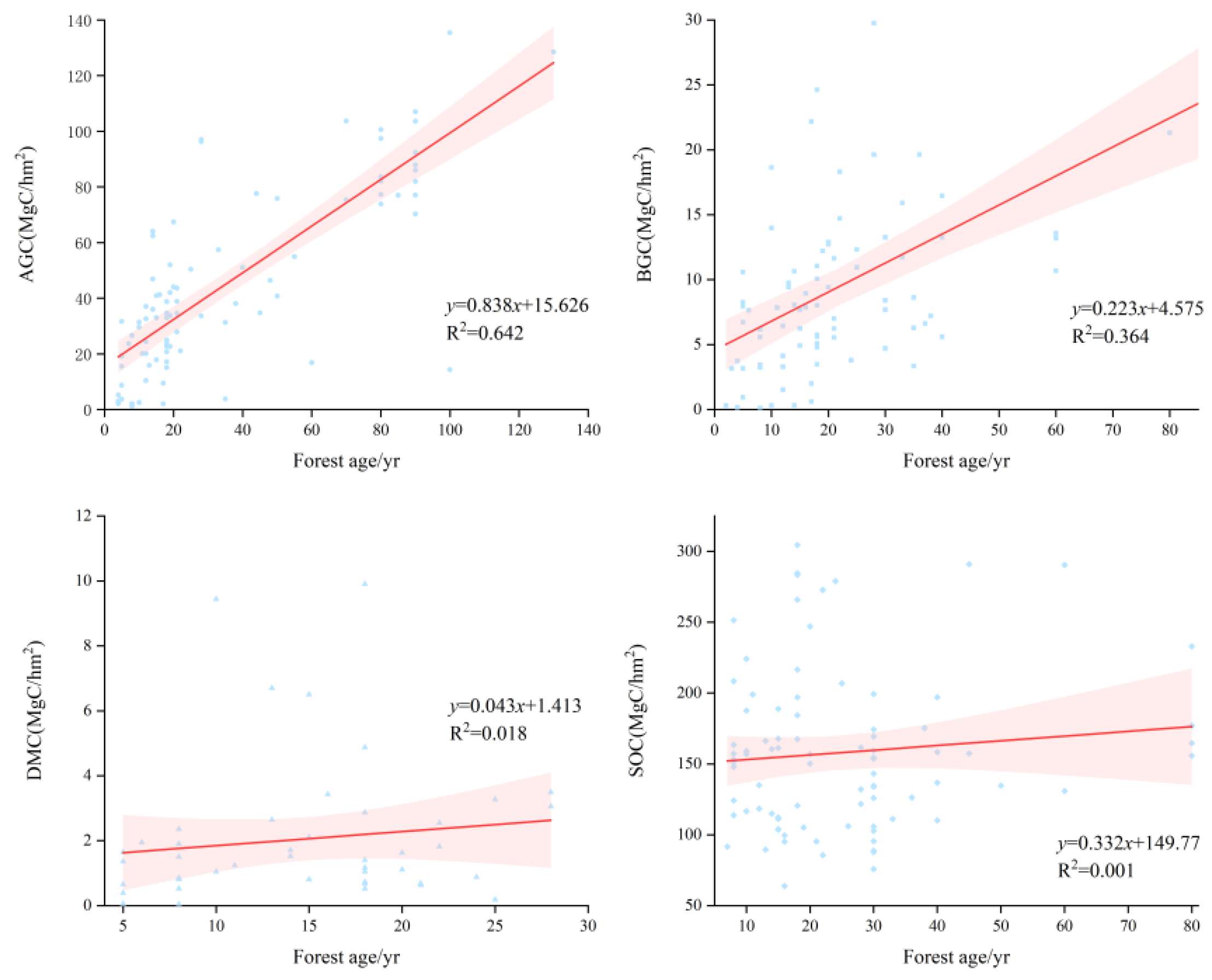

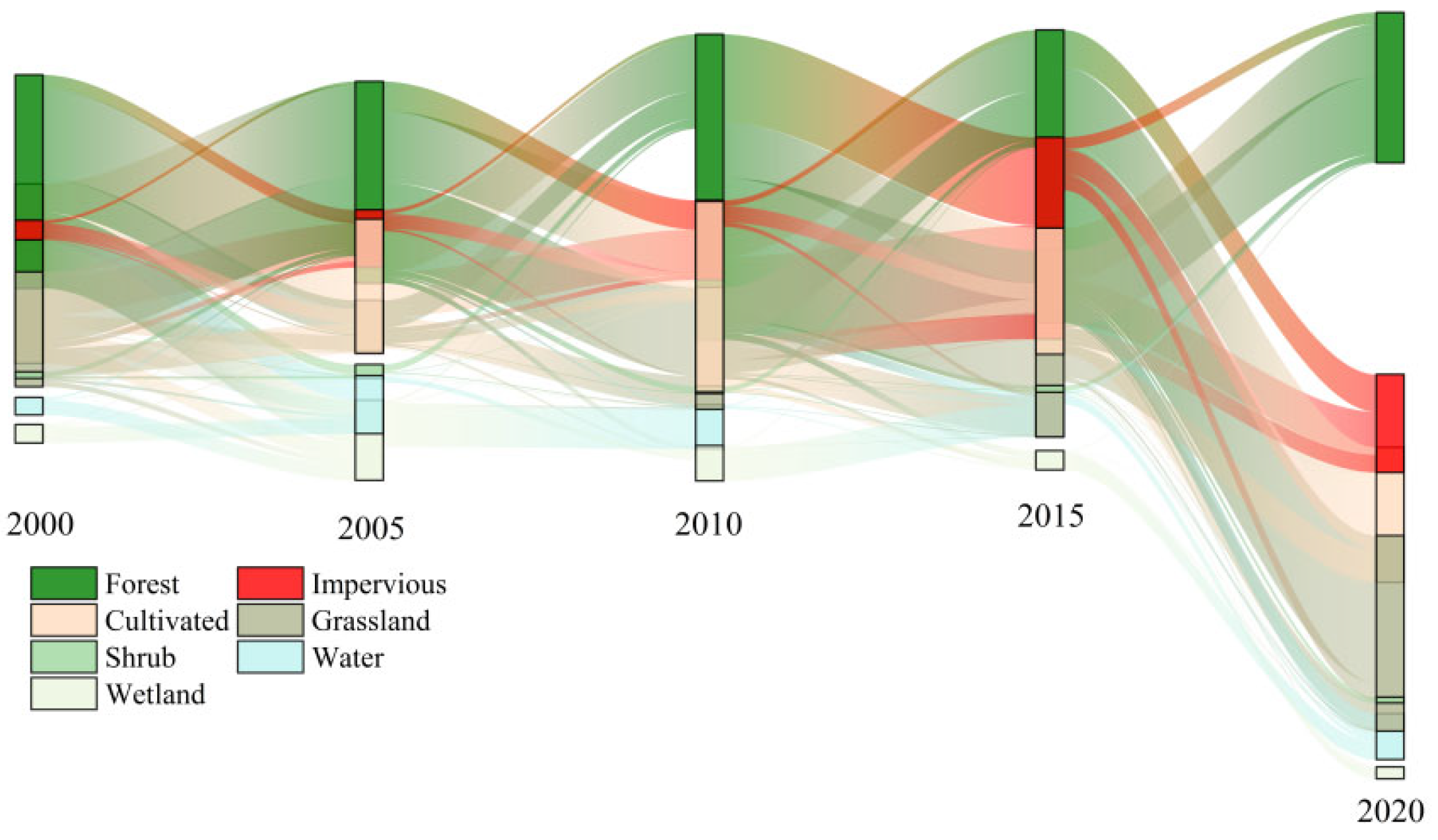
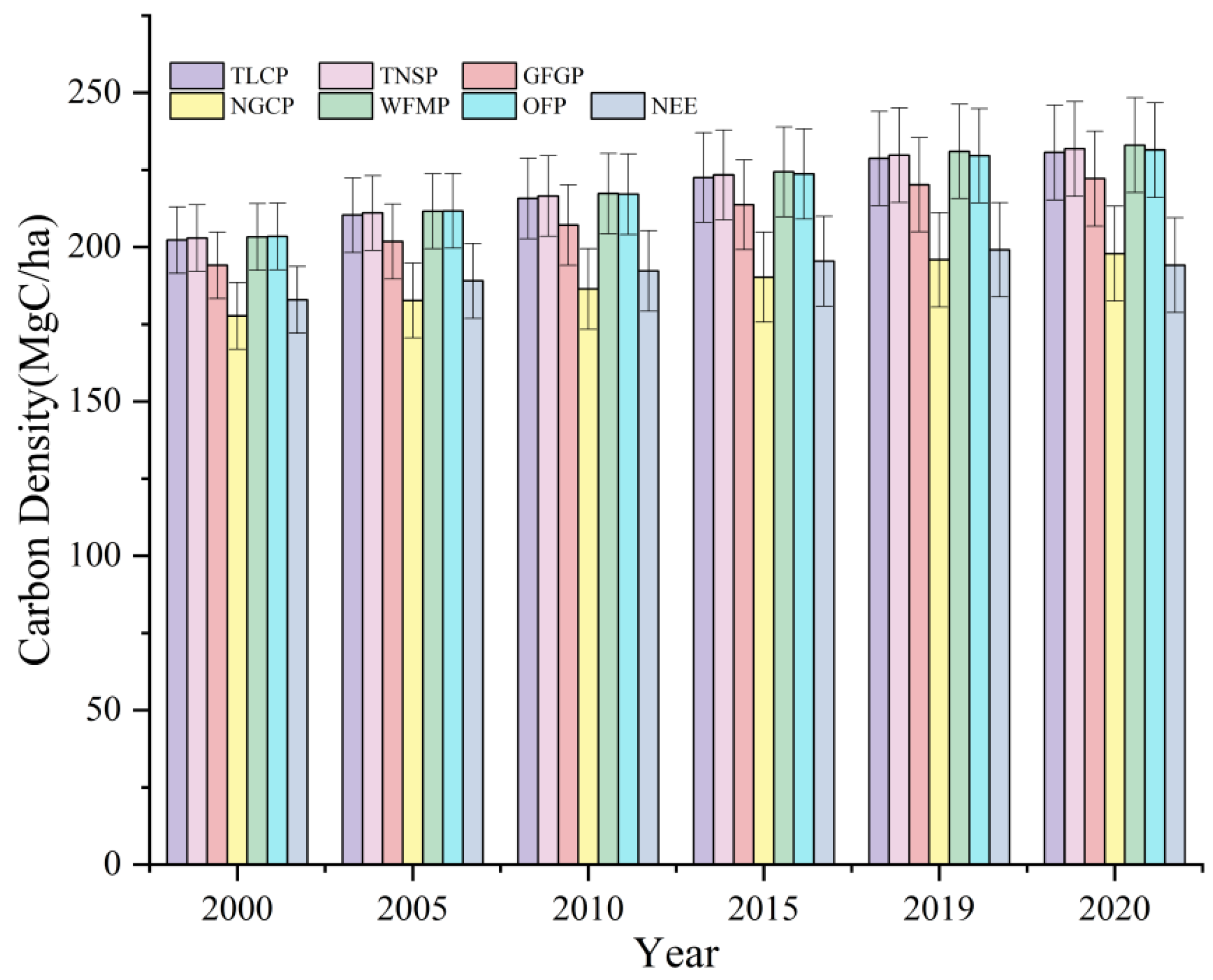
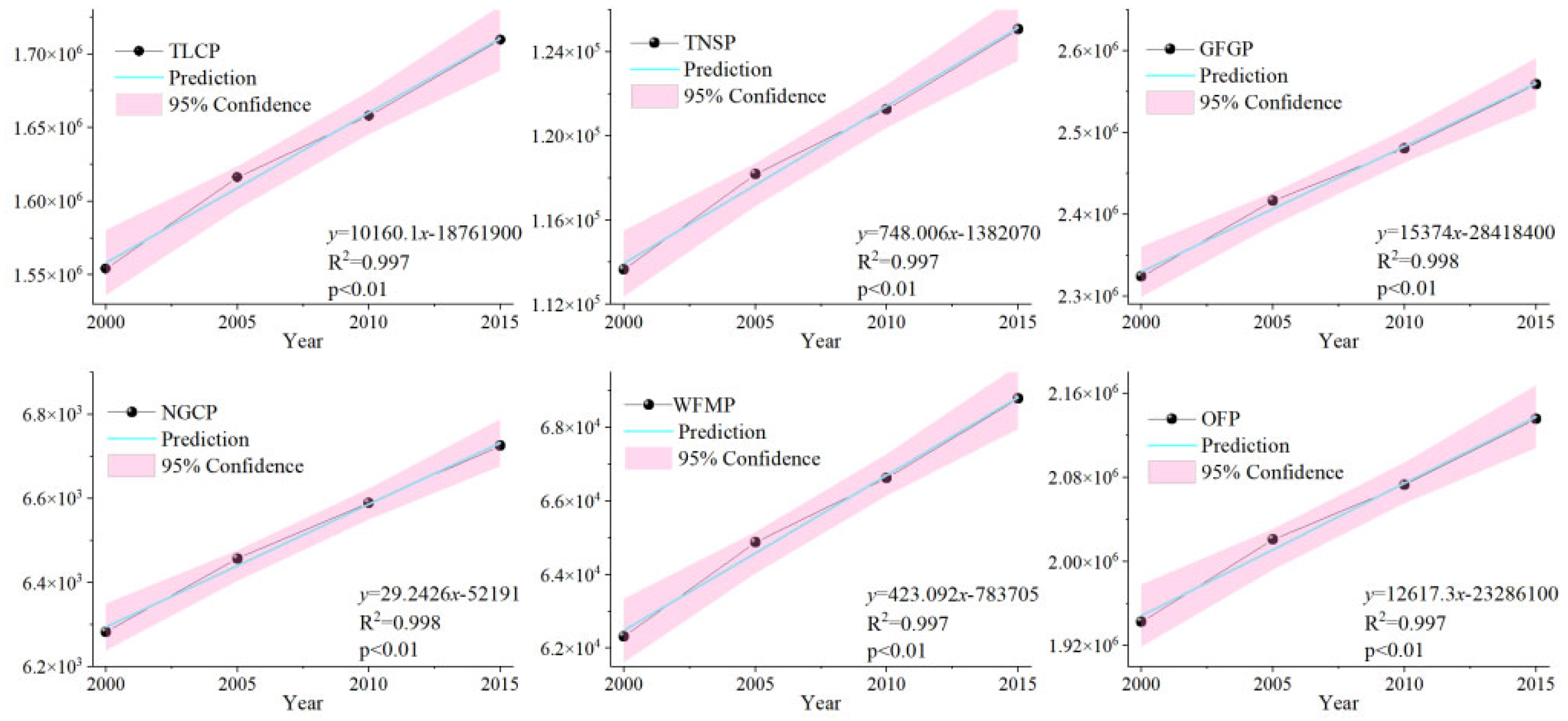
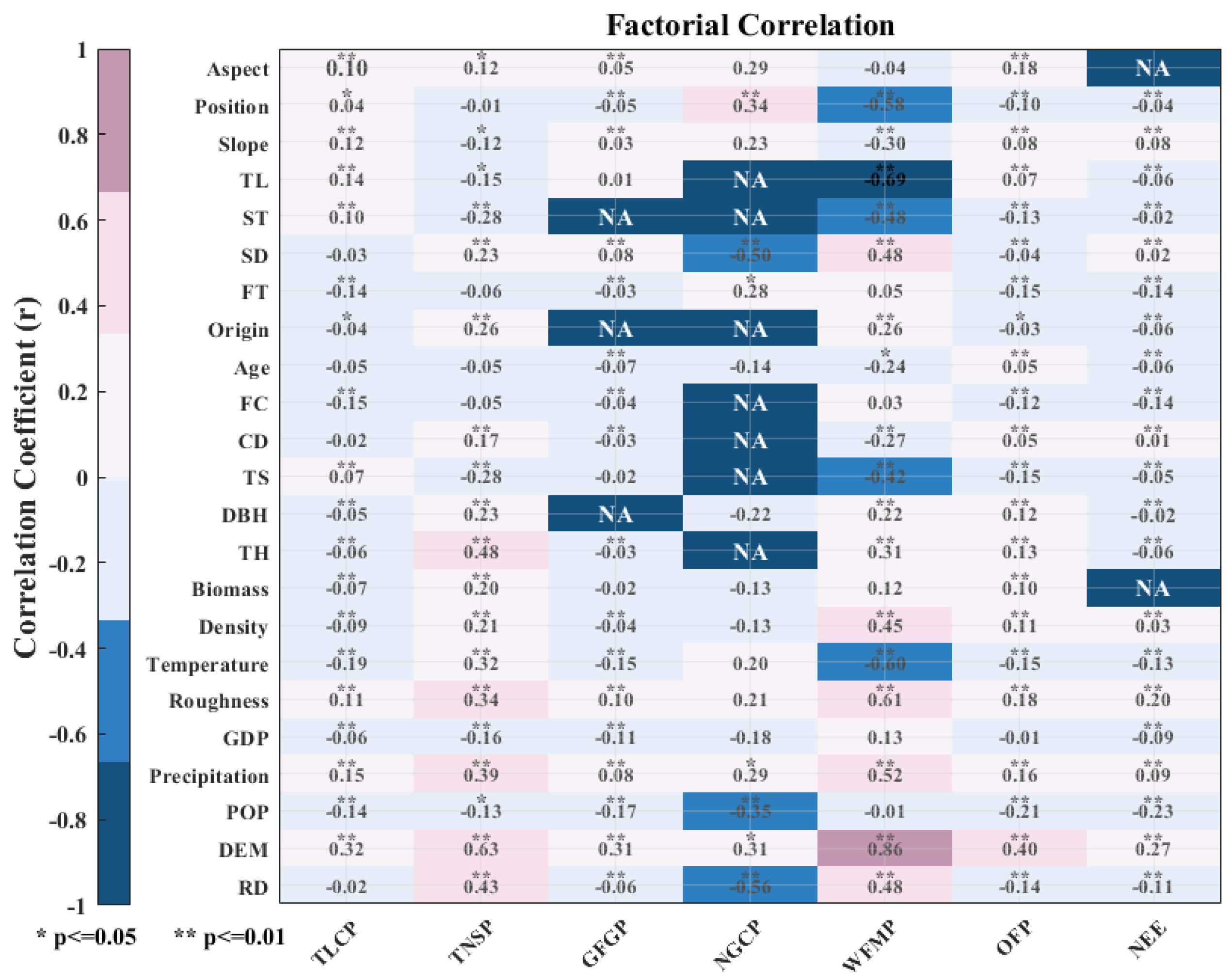


| EE | Forest Cover (%) | Tree Diameter (cm) | Accumulation (m3/ha) | Trees per Hectare (n/ha) | Tree Height (m) |
|---|---|---|---|---|---|
| TLCP | 0.56 | 1.32 | 8.02 | 163.52 | 2.37 |
| TNSP | 0.67 | 11.91 | 76.10 | 771.18 | 7.49 |
| GFGP | 0.51 | 7.94 | 68.24 | 1143.64 | 5.93 |
| NGCP | 0.28 | 1.58 | 0.41 | 110.07 | 1.42 |
| WFMP | 0.48 | 5.08 | 25.93 | 511.14 | 4.21 |
| OFP | 0.45 | 9.81 | 66.54 | 942.25 | 6.65 |
| Date Type | Resolution | Processing Method | Source |
|---|---|---|---|
| Ecological Engineering | 30 m | Processed with ArcGIS to a resolution of 30 m | County Forestry Bureau |
| Bedrock Exposure Rate, Soil Layer Thickness | 30 m | Processed with ArcGIS to a resolution of 30 m | https://sck.gznu.edu.cn |
| DEM Terrain Data | 30 m | Direct acquisition | https://www.gscloud.cn |
| Soil Data | 30 m | Kriging interpolation downscaled to study area resolution | https://data.casearth.cn |
| Land Use Data | 30 m | Image interpretation (accuracy ≥ 85%) + spatiotemporal consistency correction | https://www.geodata.cn |
| Terrain Roughness | 30 m | Direct acquisition | https://portal.opentopography.org |
| Temperature | 30 m | Kriging interpolation downscaled to study area resolution | https://www.ncei.noaa.gov |
| Precipitation | 30 m | Corrected using the vertical temperature lapse rate to a resolution of 30 m | https://data.tpdc.ac.cn |
| GDP, POP | 100 m | Data fusion estimation | https://hub.worldpop.org |
| Land Use Type | AGC | BGC | DMC | SOC |
|---|---|---|---|---|
| Cropland | 0 | 0 | 0 | 104.2 |
| Woodland | 53.42 | 14.63 | 3.35 | 164.74 |
| Scrubland | 15.01 | 9.41 | 0 | 89.93 |
| Grassland | 0.95 | 9 | 0 | 119.61 |
| Wetland | 0.65 | 0.26 | 0 | 190.64 |
| Building land | 0 | 0 | 0 | 0 |
| Water | 0 | 0 | 0 | 0 |
| Z(Gi*) Range | ≤−1.96 | [−1.95, −1.65] | (−1.65, 1.65) | [1.65, 1.95] | [1.96, 2.58) | ≧−2.58 |
|---|---|---|---|---|---|---|
| Partitions | Significant cold spot | Cold spots | Not significant | Hot spots | Significant hot spots | Very significant hot spots |
| Year | Cultivated | Forst | Shrub | Grassland | Wetland | Impervious | Water |
|---|---|---|---|---|---|---|---|
| 2000 | 433.90 | 2236.37 | 12.32 | 157.46 | 4.33 | 16.35 | 6.09 |
| 2005 | 428.14 | 2231.44 | 13.29 | 149.64 | 11.68 | 21.09 | 11.53 |
| 2010 | 424.37 | 2218.18 | 13.09 | 159.09 | 7.58 | 28.31 | 16.21 |
| 2015 | 411.10 | 2195.06 | 12.94 | 170.61 | 5.73 | 50.20 | 21.19 |
| 2020 | 412.10 | 2176.98 | 12.81 | 178.67 | 4.83 | 55.83 | 25.27 |
| Year | TLCP | TNSP | GFGP | NGCP | WFMP | OFP | NEE |
|---|---|---|---|---|---|---|---|
| 2000–2005 | 0.801 | 0.801 | 0.797 | 0.557 | 0.823 | 0.810 | 0.672 |
| 2005–2010 | 0.513 | 0.521 | 0.527 | 0.410 | 0.540 | 0.511 | 0.342 |
| 2010–2015 | 0.625 | 0.629 | 0.634 | 0.413 | 0.646 | 0.605 | 0.324 |
| 2015–2019 | 0.559 | 0.576 | 0.608 | 0.591 | 0.592 | 0.525 | 0.478 |
| 2019–2020 | 0.851 | 0.884 | 0.899 | 1.020 | 0.869 | 0.807 | −2.51 |
| Year | TLCP | TNSP | GFGP | NGCP | WFMP | OFP | NEE |
|---|---|---|---|---|---|---|---|
| 2000 | 15.54 × 105 | 1.14 × 105 | 23.24 × 105 | 6.28 × 103 | 0.62 × 105 | 19.43 × 105 | 469.12 × 105 |
| 2005 | 16.16 × 105 | 1.18 × 105 | 24.17 × 105 | 6.46 × 103 | 0.65 × 105 | 20.21 × 105 | 484.87 × 105 |
| 2010 | 16.58 × 105 | 1.21 × 105 | 24.80 × 105 | 6.59 × 103 | 0.67 × 105 | 20.73 × 105 | 493.14 × 105 |
| 2015 | 17.10 × 105 | 1.25 × 105 | 25.59 × 105 | 6.73 × 103 | 0.69 × 105 | 21.36 × 105 | 501.14 × 105 |
| 2019 | 17.58 × 105 | 1.29 × 105 | 26.37 × 105 | 6.92 × 103 | 0.71 × 105 | 21.92 × 105 | 510.70 × 105 |
| 2020 | 17.73 × 105 | 1.30 × 105 | 26.60 × 105 | 6.99 × 103 | 0.71 × 105 | 22.09 × 105 | 497.90 × 105 |
| 2019 Forecast | 17.51 × 105 | 1.28 × 105 | 26.22 × 105 | 6.85 × 103 | 0.71 × 105 | 21.88 × 105 | - |
| 2020 Forecast | 17.62 × 105 | 1.29 × 105 | 26.37 × 105 | 6.88 × 103 | 0.71 × 105 | 22.01 × 105 | - |
| Region | Carbon Storage (Mg C) | Carbon Density (Mg C/ha) | Source |
|---|---|---|---|
| Zhijin County | 54.84 × 106 | 191.29 | - |
| Nanpanjiang and Beipanjiang | 1174.07 × 106 | 140.69 | Luo et al., 2023 [44] |
| Northern Grassland of the Tibetan Plateau | 4.08 × 109 | 59.10 | Huang et al., 2023 [45] |
| China | 99.15 × 109 | 103.28 | Xu et al., 2018 [46] |
| Yangtze River Basin | 18.05 × 109 | 99.8 | Xi and Li, 2024 [12] |
Disclaimer/Publisher’s Note: The statements, opinions and data contained in all publications are solely those of the individual author(s) and contributor(s) and not of MDPI and/or the editor(s). MDPI and/or the editor(s) disclaim responsibility for any injury to people or property resulting from any ideas, methods, instructions or products referred to in the content. |
© 2025 by the authors. Licensee MDPI, Basel, Switzerland. This article is an open access article distributed under the terms and conditions of the Creative Commons Attribution (CC BY) license (https://creativecommons.org/licenses/by/4.0/).
Share and Cite
Yang, P.; Li, S.; Zhou, Z. Impacts of Ecological Engineering Interventions on Carbon Sequestration: Spatiotemporal Dynamics and Driving Mechanisms in Karst Rocky Desertification Control. Forests 2025, 16, 1361. https://doi.org/10.3390/f16091361
Yang P, Li S, Zhou Z. Impacts of Ecological Engineering Interventions on Carbon Sequestration: Spatiotemporal Dynamics and Driving Mechanisms in Karst Rocky Desertification Control. Forests. 2025; 16(9):1361. https://doi.org/10.3390/f16091361
Chicago/Turabian StyleYang, Pingping, Shui Li, and Zhongfa Zhou. 2025. "Impacts of Ecological Engineering Interventions on Carbon Sequestration: Spatiotemporal Dynamics and Driving Mechanisms in Karst Rocky Desertification Control" Forests 16, no. 9: 1361. https://doi.org/10.3390/f16091361
APA StyleYang, P., Li, S., & Zhou, Z. (2025). Impacts of Ecological Engineering Interventions on Carbon Sequestration: Spatiotemporal Dynamics and Driving Mechanisms in Karst Rocky Desertification Control. Forests, 16(9), 1361. https://doi.org/10.3390/f16091361






